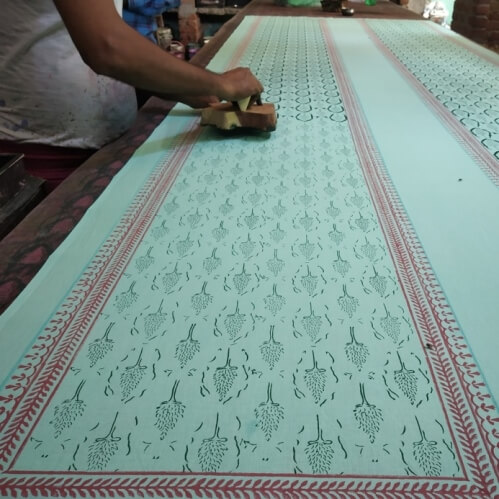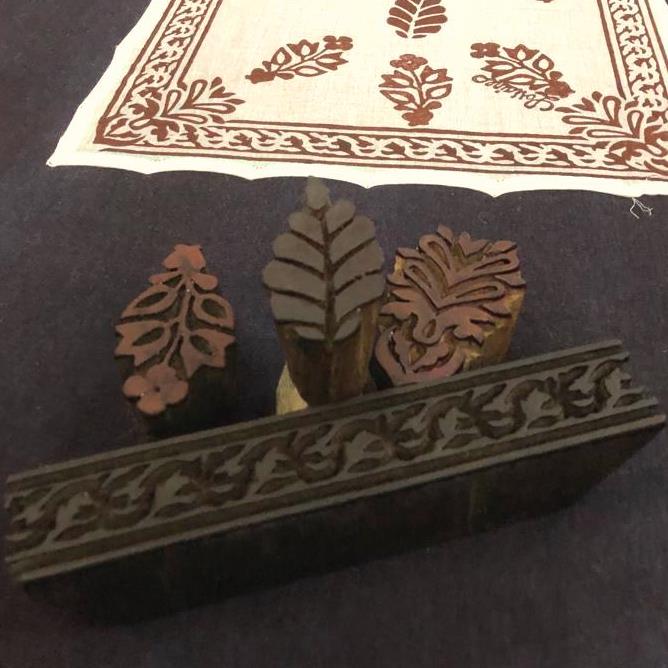The Art of Block Printing with Wooden Printing Blocks
Block printing is one of the traditional art techniques of printing that has its roots in ancient history. And Wooden Printing Block is a creative mode of printing beautiful patterns, designs, and colors on the surface wherein the images or motifs are traced and carved on woodblocks by craftsmen. The art of Block Printing is a printing technique or process that has survived somehow from ancient times to the present.
What is Block Printing
Block Printing or Relief Printing is a ancient technique for printing text, images, or patterns as a way of printing on textiles and paper that’s still used extensively today. It is a simple and instantaneous printing technique that produce rewarding results on fabric and paper. In essence, block printing is remarkably almost like rubber stamping, with many of the printing skills being transferable.
Block Printing is also an incredibly creative process, with just one wooden printing block you can create endless block printing designs and variations on a fabric, and become an instant fabric designer. Some art lovers go a step ahead and get their designs developed into their own custom wooden printing blocks to give fabric an extra unique look.

History of Block Printing

As a way of printing on cloth, the earliest surviving examples are from China date to before 220 AD. Block Printing existed in Tang China during the 7th century AD and remained the foremost common East Asian method of printing books and other texts, also images, until the 19th century.
Ukiyo-e woodblock prints are the best-known type of Japanese block printing art.
Most European uses of this technique for printing images on paper are covered by the art term woodcut, apart from the block-books produced mainly within the 15th century in India.
There have been claims by several countries having block printing originated/developed in their country but several pieces of evidence have been found in India from ruins of ancient civilizations that date back thousand years. For Example Scraps of clothing found in the ruins of Mohenjo Daro, provide evidence that block printing on fabric was practiced in India in 3000 BCE.
Since the 12th century, the art of Block Printing has flourished. The artistry flourished further with the receivable of royal patronage. Rajasthan and Surat in Gujarat became the important trading centers of printed textiles particularly in Block Print art. Today Block Printing has gained new heights by reaching the different corners of the world.
Types Of Block Printing in India
Here are the Top 10 Block Printing and Fabric Dyeing Techniques of India:
- Bagh Printing:
An indigenous printing technique from the state of Madhya Pradesh, the name originates from the Bagh district, where it is most practiced. It essentially refers to a technique of block printing by hand where the colors used are absolutely natural. - Kalamkari Printing:
Distinct kind of cotton hand-printed or block-printed material; Kalamkari originates in the state of Andhra Pradesh. - Ajrak Printing:
A particular kind of block printed shawls from the western states in India where they display designs made using block printing. - Dabu Printing:
Dabu or taboo originates in Rajasthan and is a beautiful mud resist hand block printing technique. It survived the test of time with some difficulty and is a time-consuming printing technique involving many phases and a great amount of labor. - Gold and Silver Dust Printing:
Dust of precious metals like gold and silver is used in this age-old technique to give textiles a feel of exquisite zardosi and the sparkle of gold. Over the ages, the technique has adopted the use of more affordable metals like mica and champion. - Sanganeri Block Printing:
Sanganeri is a kind of block printing that originated in Rajasthan, adorns home decor materials as well as apparel. - Bandhani Printing:
It is a ‘tie and dye’ technique that dates back to the Indus Valley Civilization, bandhani is popular amongst all. - Leheriya Printing:
A simple dyeing technique popular in Rajasthan, it results in striped textiles in a huge variety of bright colors. Cotton or silk cloth is subjected to resist dyeing. - Batik Printing:
This kind of print revolves around selective soaking of cloth in a color and preferentially printing it using wax. - Bagru Block Printing:
Being popular in Rajasthan, the printing technique is laborious but produces exquisite results.
There are two sorts of block printing famous within the states of Gujarat and Rajasthan namely- Sanganeri and Bagru. These two styles of block printing are almost the same, the thing which primarily distinguishes them from one another is the color of the background on which they are printed.
How to do Block Printing on Fabric
Block Printing is a typical process and takes time. The printers use several wooden printing blocks to complete a design. The process of block printing begins with wooden printing blocks. Woodcarvers carve designs into wood planks/blocks and the top of it has a handle for the printers to hold it.
- The first step is the preparation of printing table. Workers/Printers stretch several layers of jute fabric over a long rectangular table. The jute is a pad to supply resiliency to the printing surface/fabric.
- The second step within the process is spreading the fabric over the table and fixing it with the pins to the table.
- Printing is done from left to right. When the printer dips the printing block into the dye/color then presses it onto the fabric, the printer also slams the back of the printing block hard with the fist to create a clear impression.
- Then the printer moves the printing block to the next portion of the fabric to be colored.
- As they work, the printers pull a wooden cart bearing their printing blocks along with them. The wooden printing blocks can be interchanged from one piece of fabric to another, creating different patterns. Custom designs and different colors are often used from one fabric to a different one, creating still more individual work.
- Each color of a design is completed by a special printer, coming behind the one before and repeating the method. The process requires teamwork, as each subsequent printer must place the block accurately to make a gorgeous, whole pattern.
- Once the pattern is finished on the entire length of cloth, the piece is treated to repair the dyes. This process of block printing has been used for centuries and is still in practice.
If you wish to try hands-on block printing you can buy wooden printing blocks at https://www.rrprintingtools.com
Blocks are smaller and easy to use.
CONCLUSION
All the Wooden block printing techniques and tie and dye prints that are practiced in India boast of the rich culture and heritage of the country. Creativity, craftsmanship, and a whole lot of effort go into keeping these printing techniques alive and trending around the globe.
Different designs and techniques contribute to the popular saying of “unity in diversity”. The variety of various colors including intricate designs may be a rich source of culture that has been handed down and delicately preserved within the country. They deserve all the patronage and love that they will get.
If you want read more about Indian Traditional Printing techniques, like art of block printing, then click on the link below:
Blog
